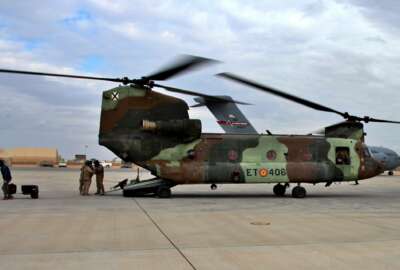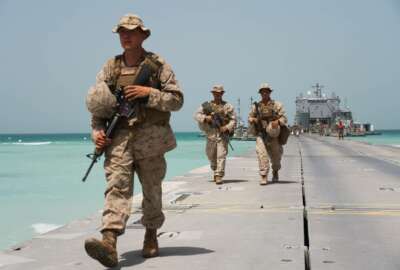
Critical software not working in F-35 fighter jets
Hard to believe as it might be, a central and critical software system of the F-35 Joint Strike Fighter simply doesn't work. And that's making people who maintain...
Best listening experience is on Chrome, Firefox or Safari. Subscribe to Federal Drive’s daily audio interviews on Apple Podcasts or PodcastOne.
Hard to believe as it might be, a central and critical software system of the F-35 Joint Strike Fighter simply doesn’t work. And that’s making people who maintain and certify the readiness of the expensive jet a little crazy. Federal Drive with Tom Temin got the latest from Diana Maurer, the director of Defense Capabilities and Management issues at the Government Accountability Office.
Interview transcript:
Tom Temin: Mrs. Maurer, good to have you back.
Diana Maurer: Good morning, Tom. Great to be back on the show.
Tom Temin: So this is the ALIS system, ALIS, which is central to the maintenance and writing this, if not the combat systems. Is that a good way to put it?
Diana Maurer: Right. So ALIS is an acronym, like many things at DoD for the autonomic logistics information system. That, of course, doesn’t tell you anything about what it does, but basically it’s the heart of operating and maintaining the F-35. And like the aircraft itself, it’s very complex. It’s very multifaceted, and it’s very ambitious. It was designed to make maintenance, supply and operations easier and more efficient. But as you noted in opening our conversation this morning, it has not delivered on those promises.
Tom Temin: And this goes back so many years, the development of this. It’s probably 20 years that they’ve been working on ALIS. What this issues at this point?
Diana Maurer: Well absolutely. You’re absolutely right. This goes back 20 years or more. The F-35 program itself was launched in October of 2001. So that means that in the late 1990s or mid 1990s, there, thinking conceptually about what eventually became ALIS, and where we are today is that there is a big gap between what ALIS was planned to do and what it’s actually doing. For example, if you’re a mechanic on an F-35, the concept was that your you plug the F-35 into the system. ALIS does the diagnostics check on the aircraft. It can figure out whether parts need to be replaced or are on the brink of being needed to be replaced. That information’s uploaded into a system. The parts are ordered automatically, so you have a seamless ability to both troubleshoot problems and manage inventory. The reality is that interface is not working as planned. It has never worked as planned, and what we found in either visiting or gaining information from all 10 of the U.S. Bases where F-35s were deployed is that there is a great deal of frustration among mechanics among pilots and among commanders.
Tom Temin: And one of the things you’ve discovered or reported on in the latest look see at this, the hardware seems to be dated on the interface to the software that the operator would see is really difficult to navigate. It sounds like they’re still kind of in 1970 with in that respect,
Diana Maurer: Yeah, there are definitely real gaps. You know. One of the ironic things is that ALIS was designed to help the user. It was designed to make life easier for pilots, mechanics, commanders, logisticians. What we’ve been hearing, though, from people in the field who use ALIS every day is that in many respects it makes their life more difficult. For all the reasons that you pointed out, the user interface in particular is not user friendly. When you talk to users, particularly some of the younger mechanics right, who grew up in in a different age, they’re frustrated by the in their view, outdated interface. So there’s a lot of there’s a great need to update both the hardware and the software to make ALIS fulfill that promise of what it was designed to do in the first place.
Tom Temin: And looking at the report, I guess the other theme that emerges pretty clearly is that DoD’s process for managing it, for understanding what it needs to do and when it needs to do it and how is not real strong either?
Diana Maurer: Exactly. We issued a report six years ago in 2014 that recommended that DoD develop a set of performance measures to get a better understanding of how well ALIS was working. At that time we also talked to users, we also heard a great deal of concern about the system. DoD agreed with that recommendation, but they never fully implemented it. We issued another report in 2016 also highlighted problems with challenges deploying the system, missing, or inaccurate data, poor user experience and other problems. And again, those those problems have not been fully rectified. So we think it’s important for there to be a clear yardstick for what a good version of ALIS looks like. Without that yardstick without performance measures, the program office and the contractor can keep saying that that is getting better. But the users can keep saying it’s not good enough.
Tom Temin: And given the platform that it was developed on, Can it be rectified, do you think?
Diana Maurer: I think it can be rectified? And you know, one of the encouraging things about our most recent report, which was issued just a few weeks ago, is that the Defense Department has concurred with with our recommendations, and we do notice a real significant change on their overall focus and attention on fixing ALIS. So it is possible. It is not going to be easy. And one of the things that we noted in our report is that the path forward is still not clear. So, for example, a number of very important and foundational issues on whatever the future of ALIS is going to be still need to be resolved. Things like who actually owns the software, so issues of you know how much of it’s going to be owned by the contractor and how much access to core software is the government going to have? How much of the system is going to navigate to the cloud? I mean, currently, ALIS, some portions of ALIS are used predominantly through hardware servers, heavy servers that need to be deployed with the units. And there’s still a fundamental debate discussion going on about whether or not the underlying software needs to be modified or entirely entirely replaced. Now there are a lot of different efforts that are going on associated with DoD. And the contractor. In fact, one of the things we noted was that there was a what we called in our report a chorus of divergent views on what should be done to fix and improve ALIS. We think that DoD needs to develop a clear strategy, resolve some of these fundamental issues and move out on improving the system as soon as possible.
Tom Temin: And if they decided, well, let’s just replace it, is there anything commercial out there for, like airliners or something could conceivably be installed in its place?
Diana Maurer: Well, certainly, right now there are other weapons systems that have systems that are not dissimilar to some of the things that ALIS is trying to do. ALIS, however, is unique in its level of complexity and its its ambition. It’s also essentially, at this point, owned entirely by the prime contractor, Lockheed. So Lockheed will continue to be an important partner, working with the government to develop any fixes to ALIS. In fact, DoD has recently announced that they’re going to transition the program to a new acronym, ODIN, the Operational Data Integrated Network. And we’re going to be keeping a close eye on that to see how much progress is being made because we think it’s this is so important to the ability of the F-35 to execute its mission. It’s so important for the ability of the future capabilities of U.S. air power that we’re going to continue to provide our independent oversight and support congressional decision making.
Tom Temin: And there’s something a little bit original in this report in that is very short paragraph. But you have matter for congressional consideration, legislation requiring DoD to establish a performance measurement process for ALIS. That’s not in every report. Hey, Congress, maybe you should legislate that this program get on track,
Diana Maurer: Right. Exactly. GAO does not do that very often. In this case, it was a reflection of some level of, frankly frustration on our part that we had recommended that DoD do this back in 2014 develop performance measures to figure out whether or not ALIS is actually working as planned. They had not done so, and we thought it was an important enough of an issue to flag for congressional attention. So we’ve had discussions with members and with staff about this, and now it’s in Congress’s ballpark right now to decide what they what they choose to do. I do know that this is an issue of great interest on the armed service is committees, and I also know it’s something that DoD leadership is taking very seriously. So we are encouraged by all of that. But the same time we’ll be continuing to provide a sharp, independent eye to keep track on progress along the way.
Tom Temin: Diana Maurer is director of defense capabilities and management issues at the GAO . As always. Thanks so much for joining me.
Diana Maurer: Thank you very much. Tom.
Copyright © 2025 Federal News Network. All rights reserved. This website is not intended for users located within the European Economic Area.




